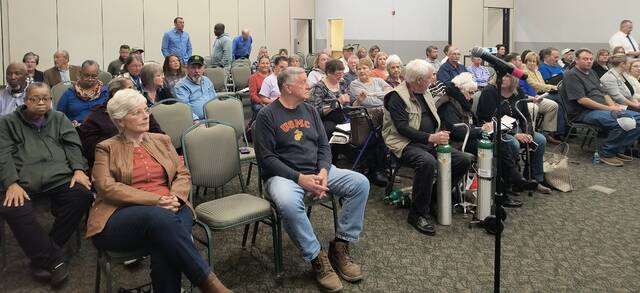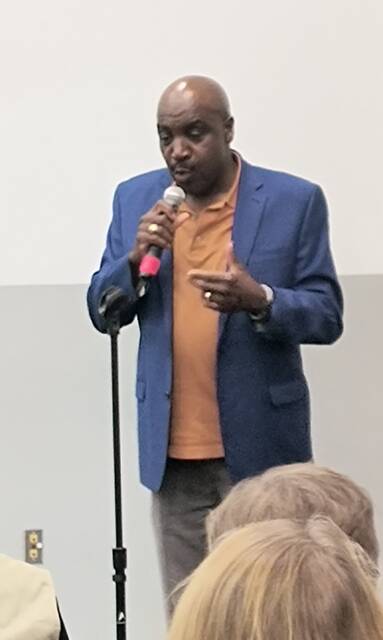
Widely attended, the Hamlet community recieved support from former county commissioner Pam Dillman and Dobbins Heights Mayor Antonio Blue.
HAMLET — A public hearing to address the ongoing legal saga of International Tie Disposal opening a biochar production facility on Mark’s Creek Church Rd. was held on Monday, March 18 in the Cole building by DEQ. Representatives from DEQ as well as from Polivka International, the parent company which is headquartered in Weddington, were present at the meeting to listen to community concerns and feedback regarding the storm water permit project.
Golisano Institute for Sustainability at the Rochester Institute of Technology states, “Biochar is a carbon rich material that is made from biomass through a thermochemical conversion process known as pyrolysis.” The United States Department of Agriculture explains this process as “the heating of organic material, such as biomass, in the absence of oxygen.” and adds that “because no oxygen is present the material does not combust but the chemical compounds (i.e., cellulose, hemicellulose, and lignin) that make up that material thermally decompose into combustible gases and charcoal.”
If granted, the permit would allow a biochar production facility to be in operation on Mark’s Creek Church Rd., one and a half miles from Hamlet’s extraterritorial jurisdiction, and approximately ten miles from Monroe Avenue Elementary School and Richmond County Ninth Grade Academy. The facility is projected to burn railroad ties, some contaminated with a cancer causing substance known as creosote. Used since the mid-1800’s as a wood preservative, creosote is derived from the distillation of tar from wood or coal. Creosote is an active ingredient used in treating wood products designed for outdoor use, in order to protect the wood product from environmental hazards.
According to the proposed project, International Tie plans to run 426 kilns on site. An estimated 160 kilns per day will be in operation at the facility, while the remaining kilns are prepared for the following day’s operations. Each kiln is anticipated to process roughly 2,000 pounds of wood materials such as creosote soaked railroad ties or untreated lumber. The facility will also house 62 natural gas-fired afterburners on site and has a proposed operation schedule of running 24 hours per day, 7 days a week, 365 days per year.
Basil Polivka, a representative of Polivka International, explains that Hamlet was chosen because, “We were approached many years ago about the issue of railroad ties being stacked up all over the country. There is no really good way to get rid of them and a lot of times they just sit along the right of the way of the tracks. Hamlet has a big rail facility and so is looked upon as a favorable location for the facility to operate.”
Speaking at the hearing, former Richmond County Commissioner Pam Dillman, said, “They have already started burning…There are thousands of ties on the ground now to be burned and they are burning two to five days a week now. That is the air that you see in the afternoons on the days that they burn.”
Many members of the community shared their concerns that burning of railroad ties is currently taking place prior to the company securing a permit to do so. Polivka is perplexed by this saying, “I do not understand that misconception… we do not currently have power at the facility so there is no way we could be firing up the kilns at this time.”
A major source of contention for Dillman, and others, is a $500,000 check the county received to beautify the area. Expressing dismay, Dillman asked, “What does that mean? They got paid off… every single one of the commissioners and the members of the planning board.”
Dillman, who is on oxygen, is concerned along with many residents in the community, about a potential rise of cancer diagnoses in the county from breathing in air particles from the burning creosote.
Mayor of Dobbins Heights, Antonio Blue, shared that his father worked for the railroad for 47 years before he and several of his co-workers passed away from cancer.
“This facility will only bring fifty new jobs to the area. I asked officials would you build your house near it? I received no answer so I guess that was his answer. God gave us three things to take care of: air, water, and the land. This will destroy all three,” declared Blue.
Supporting Mayor Blue’s comments, Heather Hudson added, “We do not need more jobs. We need better healthcare.”
Many citizens expressed feeling betrayed by local leaders.
Debra David, a Dobbins Heights resident and breast cancer survivor, stated, “Our government officials are supposed to be doing this fighting for us. I want DEQ to do their job instead of sitting there smiling and writing things down. We are a dumping ground. We are going to fight and we are going to win. We are not going to lose,” declared David to thunderous applause.
Agreeing with David, Jesse McQueen added, “ We are a poor county in the middle of poor counties and we are in a location where it is easy to get ties here. Officials made an agreement that benefitted nobody but the county budget. Elected officials sold us out,” lamented McQueen.
Following public comments, Polivka addressed the crowd, expressing his dismay that, “There are a number of misconceptions concerning the project that we hope will be cleared up. I came here because I want to hear public comments. Our main goal in coming tonight is to hear what you have to say.”
Largely shouted down and peppered with questions, Polivka was unable to state much more. As he regained his seat the crowd again erupted with one individual questioning, “What do you in Weddington know about the railroad?”



